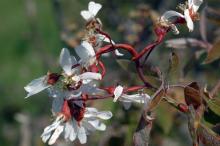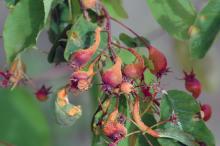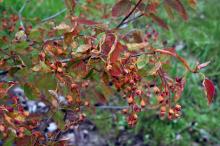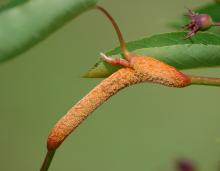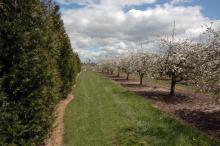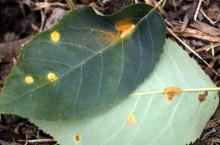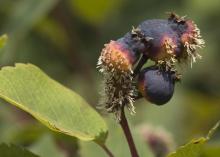See:
Pear (Pyrus spp.) - Pacific Coast Pear Rust
Cause Seven Gymnosporangium spp, fungi. The spore stages produced on serviceberry or others in the rose family do not reinfect these hosts. They infect only alternate hosts, which include junipers or cedars, during one summer. Spore stages produced on junipers and cedars infect only members of the rose family in early spring during wet weather. Infection on the conifer host is perennial where spores may be produced over a 2- to 3-year period.
Symptoms Undersides of leaves develop circular yellow to orange lesions (aecia). When mature, aecia develop numerous spore horns, which protrude from the leaf surface in a rosette pattern. Aeciospores may be yellow or brown. Spore horns may form only on fruit, petiole, small twigs and/or leaves, depending on the rust species. Defoliation, swellings of petioles and twigs, mummification, or destruction of the fruit also may occur. Rust infected shoots tend to not survive the next winter.
On the juniper or cedar host, witches' brooms or swellings and galls of branches can be observed. Yellow to orange telial horns are produced in the spring.
Cultural control
- Remove or widely separate from all junipers or cedars. Specific junipers or cedars can be removed only when the rust species has been correctly identified. Separating hosts by 0.5 to 2 miles has also been recommended.
Chemical control Growers have had mixed results when using various chemicals to control this disease. Some chemicals have been found phytotoxic to certain cultivars but not to others. Use multiple applications at two-week intervals starting at bud break.
- Avelyo at 8 to 10 fl oz/100 gal water. Although label indicates suppression only, it was excellent in a western Oregon test. Group 3 fungicide. 12-hr reentry.
- Armada 50 WDG at 3 to 9 oz/100 gal water. Do not use a silicone-based surfactant. Not for nursery or greenhouse use. Group 3 + 11 fungicide. 12-hr reentry.
- Banner MAXX at 5 to 8 fl oz/100 gal water. Although not listed for this pest, it is effective. Do not apply to edible types. Group 3 fungicide. 12-hr reentry.
- Compass 50 WDG at 2 to 4 oz/100 gal water plus a spreader-sticker. Do not use organosilicate additives. Group 11 fungicide. 12-hr reentry.
- Eagle 20 EW at 6 to 12 fl oz/100 gal water. Group 3 fungicide. 24-hr reentry.
- Mural at 4 to 7 oz/100 gal water. Group 7 + 11 fungicide. 12-hr reentry.
- Myclobutanil 20 EW T&O at 6 to 12 fl oz/100 gal water plus spreading agent. May observe a PGR effect. Group 3 fungicide. 24-hr reentry.
- Orkestra at 4 to 11 fl oz/100 gal. Use high rate in western Oregon. Group 7 + 11 fungicide. 12-hr reentry.
- Ortho Rose & Flower Disease Control at 2 fl oz/gal water. Group 3 fungicide. H
- Spectracide Immunox Multi-Purpose Fungicide Spray Concentrate for Gardens at 1 fl oz/gal water. Group 3 fungicide. H
- Tourney EZ at 1 to 4 oz/100 gal water. Group 3 fungicide. 12-hr reentry.
References Pscheidt, J.W. and Bassinette, J.P. 2007. Comparison of fungicides for control of rust on Serviceberry, 2006. PDMR 1:PF042.
Ziller, W.G. 1974. The Tree Rusts of Western Canada. Canadian Forestry Service Publication 1329.


